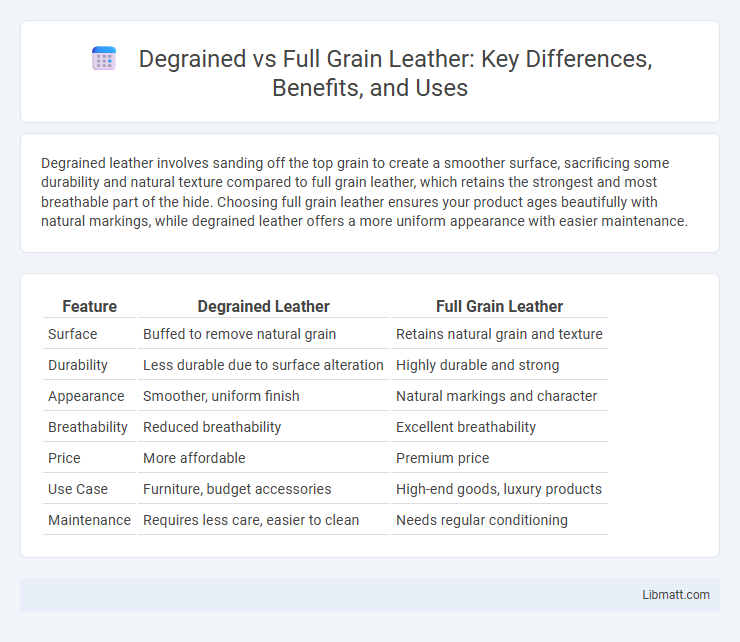Degrained leather involves sanding off the top grain to create a smoother surface, sacrificing some durability and natural texture compared to full grain leather, which retains the strongest and most breathable part of the hide. Choosing full grain leather ensures your product ages beautifully with natural markings, while degrained leather offers a more uniform appearance with easier maintenance.
Table of Comparison
| Feature | Degrained Leather | Full Grain Leather |
|---|---|---|
| Surface | Buffed to remove natural grain | Retains natural grain and texture |
| Durability | Less durable due to surface alteration | Highly durable and strong |
| Appearance | Smoother, uniform finish | Natural markings and character |
| Breathability | Reduced breathability | Excellent breathability |
| Price | More affordable | Premium price |
| Use Case | Furniture, budget accessories | High-end goods, luxury products |
| Maintenance | Requires less care, easier to clean | Needs regular conditioning |
Introduction to Leather Types
Degrained leather, often referred to as corrected grain leather, undergoes surface sanding to remove imperfections, making it more affordable and easier to maintain than full grain leather. Full grain leather retains the natural grain layer, offering superior durability, breathability, and a distinct patina that develops over time. Both leather types are popular in furniture, footwear, and accessories, with full grain valued for premium quality and degrained providing a budget-friendly alternative.
What is Full Grain Leather?
Full grain leather is the highest quality leather, made from the top layer of the hide, preserving its natural texture and strength. It retains the full thickness of the hide, including the grain layer, which allows it to develop a rich patina over time and resist wear better than other types. Understanding the durability and authenticity of full grain leather can help you make informed decisions when choosing premium leather products.
What is Degrained Leather?
Degrained leather is a type of leather that has undergone a mechanical process to remove the natural grain layer, resulting in a smoother and more uniform surface. This process eliminates imperfections and creates a consistent texture, often making degrained leather more affordable and versatile compared to full grain leather. If you're seeking durability with a refined appearance, understanding the distinction can help you choose the right leather for your needs.
Key Differences Between Degrained and Full Grain Leather
Degrained leather undergoes a mechanical process that removes the natural grain, resulting in a smoother, more uniform surface but with less durability and breathability compared to full grain leather. Full grain leather retains the complete natural grain, showcasing unique markings and enhancing strength, aging beautifully to develop a rich patina over time. Your choice between degrained and full grain leather impacts longevity, appearance, and maintenance, with full grain offering superior quality for premium uses.
Durability and Strength Comparison
Full grain leather offers superior durability and strength due to its intact top-layer surface, maintaining the natural fibers and grain structure. Degrained leather, processed to remove the natural grain, is generally less strong and more prone to wear and tear over time. For applications requiring long-lasting resilience, full grain leather outperforms degrained leather by preserving the material's original toughness and resistance to stretching.
Appearance and Texture Variations
Degrained leather features a uniform, smooth surface achieved by removing the natural grain, resulting in fewer imperfections and a more consistent appearance. Full grain leather retains the natural texture and markings, showcasing unique grain patterns and leading to greater tactile richness. The distinct surface variations influence both the aesthetic and feel, with full grain offering a rugged, authentic look, while degrained leather appears more polished and refined.
Maintenance and Care Requirements
Degrained leather demands less frequent maintenance due to its protective coating that resists stains and scratches, making it ideal for everyday use. Full grain leather requires regular cleaning and conditioning to maintain its natural texture and prevent drying or cracking, preserving its durability and rich patina. Both types benefit from proper storage and avoidance of excessive moisture to extend their lifespan.
Cost and Value Considerations
Degrained leather typically costs less than full grain leather due to its lower durability and surface treatment that masks natural imperfections. Full grain leather offers greater long-term value because its natural fibers enhance strength, develop a rich patina, and age beautifully over time. When investing in your leather goods, choosing full grain leather ensures superior quality and longevity despite the higher initial cost.
Best Uses for Degrained and Full Grain Leather
Degrained leather, with its smooth surface and consistent texture, is ideal for fashion accessories, upholstery, and footwear where a polished, refined look is desired. Full grain leather, known for its durability and natural markings, is best suited for high-quality furniture, heavy-duty boots, and luxury handbags that benefit from its strength and aging properties. Choosing between degrained and full grain leather depends on the balance of aesthetic preference and performance needs in the intended application.
Choosing the Right Leather for Your Needs
Degrained leather features a sanded and treated surface for a uniform appearance, making it more resistant to stains and easier to maintain, ideal for those seeking durability with less upkeep. Full grain leather retains the natural texture and imperfections, providing superior strength, breathability, and a unique patina over time, perfect for users valuing authenticity and long-term quality. Your choice depends on whether you prioritize low maintenance and uniformity or natural aesthetics and enhanced durability.
Degrained vs full grain leather Infographic

 libmatt.com
libmatt.com